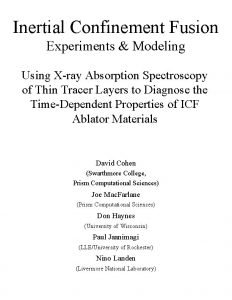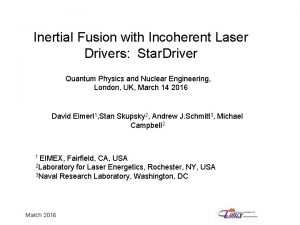Inertial Electrostatic Confinement Fusion Reactor Liquid Cooled Ion

- Slides: 1

Inertial Electrostatic Confinement Fusion Reactor Liquid Cooled Ion Accelerating Grid Design A. Seltzman, Georgia Institute of Technology Abstract: Reactor Design: Traditional inertial electrostatic confinement (IEC) fusion reactor designs utilize an ion accelerating grid fabricated out of a refractory metal capable of operating at high temperatures to radiate off heat imparted by ion-grid collisions. Unfortunately, the high gird temperature allows for a substantial thermionic electron emission current, requiring a high power draw and significantly reducing reactor efficiency. Further, electrons emitted from the grid are accelerated into the reactor shell where they generate a significant amount of bremsstrahlung x-rays requiring additional shielding and increasing system size and weight. Presented is a novel modification to the traditional implementation of IEC fusion reactor, designed to improve operating efficiency by reducing electron emission from the grid. A liquid cooled grid design is utilized to reduce thermionic electron emission, allowing for higher plasma densities, and greater input power while improving system efficiency and reducing x-ray output. The resulting low grid temperatures substantially reduce thermionic electron emission and greatly improve reactor efficiency by reducing current draw from the central grid. The reduction of thermionic electron emission will eliminate the majority of bremsstrahlung x-ray generation thereby reducing shielding requirements. By measuring the heat deposited into the coolant, the grid cooling system may also be used as a diagnostic tool to study the physics involved in IEC reactors. In this manner, grid transparency may be directly measured as a function of ion bombardment heating. By modifying the confinement scheme of the reactor and subsequently evaluating the energy flux to the grid through ion collisions, greater energy and particle confinement times may be obtained. Neutron Detector Vacuum Hub ECRF Drive Amplifier Primary Cooling Radiator Vacuum Envelope Mark 3 IEC Reactor Core • Modular, portable design • Ions oscillate in electrostatic field • Labview Control, USB interface Cooled Grid Assembly • By comparing grid heating to reactor drive power, a direct measurement of grid transparency may be obtained • The resulting trends in heating vs. input power and pressure may be used to determine stable operating regions for non-cooled grid reactors Cooled Ion Accelerating Grid Design Grid Cooling Data • Low operating temperature to reduce thermionic electron emission current. Grid Heating • High voltage bias (-50 k. V) • A fraction of the accelerated ions collide with the grid heating it. • Three ring grid fabricated from 1/16” OD stainless steel tube • A radiatively cooled grid will operate at high temperatures • Non-conductive Fluorinert coolant • As plasma impedance increases, grid heating power fraction decreases • As plasma density decreases, slope of Grid Heating vs. Drive Power decreases • As drive power increases, plasma impedance decreases • High flow rate (1 ml/s at 80 PSI) • Ceramic cooling system isolation Ion Bombardment Heating Deuterium Plasma: 13 k. V, 5 m. A, 16 m. Torr • By measuring coolant feed and return temperature, ion bombardment heating power and grid temperature may be directly measured • Cooled grid design reduces unwanted x-ray emission • Onboard ECRF drive system • At high temperatures the grid emits a large thermionic electron current, generating a substantial power draw Diagnostic Use of Grid Cooling • On demand deuterium generation from heavy water reserve Ion Trajectory • Grid serves as diagnostic tool to determine fraction of drive power dissipated into grid heating IEC Reactor Core Design • High efficiency neutron production • Central grid negatively biased • Fusion generated high energy neutrons and protons • Cooled grid remains below 45 C at 155 W drive power. Fluorinert Micropump Problem to be Solved: • Ions collide at focal point and fuse • Deuterium fusion detected via neutron generation Accelerating Grid System Reactor Design Deuterium Fusion Reactor Operational ECRF Injector IEC Fusion Overview: • Grid heating due to ion bombardment causes thermionic electron emission, thereby increasing reactor power draw and generating unwanted x-ray radiation. Results: Ion Accelerating Grid • Vacuum compatible alumina ceramic feedthroughs Future Work: • Emitted electrons are accelerated into the reactor shell where they generate bremsstrahlung x-rays. ECRF Injector System • RF drive system operational, Injector system in testing Grid Cooling System • Primary cooling loop radiator removes heat from water Grid Cooling System • Water cooled Fluorinert chiller assembly Thermionic Electron Emission Solution: • A liquid cooled ion accelerating grid remains cool at high operating power, allowing increased plasma density and higher operating efficiency by eliminating thermionic electron emission. • RF ionization of X-mode electron cyclotron resonance at 880 MHz • Provides low pressure stability • Increases plasma density and energy while reducing ion-grid collisions • Thermoelectric chiller assembly allows compact, high performance cooling of grid ECRF Ion Injector Design • Fluorinert grid cooling loop Results and design documentation posted at: Fluorinert Chiller www. rtftechnologies. org ECRF Ion Injector Assembly

